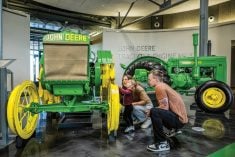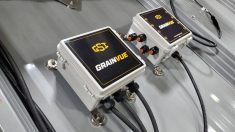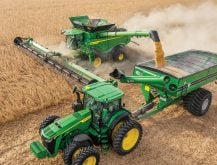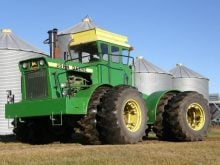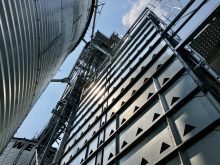Most grain producers have spent time at an elevator waiting to find out the protein level of a truckload of wheat after delivering it. That, of course, makes a difference to the size of cheque the elevator manager is willing to write.
Today, John Deere is taking the suspense out of that wait by making it possible to determine protein or oil content information on wheat, barley or canola right on the combine in the field, and on the go. Deere is offering an updated version of its HarvestLab 3000 system that is now capable of grain sensing. It can be retrofitted to 2018 model year or newer John Deere S700 series combines.
Grain sensing is the fourth application of the HarvestLab 3000. Deere initially made the system available for its line of self-propelled forage harvesters to monitor the quality of the feed coming out of their spouts. It then added the ability to monitor the quality of liquid manure being spread on a field. HarvestLab could also be used as a stationary device to analyze feed quality samples.
Read Also

Claas brings 1000 Series SP forage harvesters to Canada
In mid-August, Claas unveiled its new line of Jaguar forage harvesters at an event in Visalia, California, deep in the heart of that state’s dairy region.
The new grain sensing feature continuously measures and monitors protein, starch and oil values in wheat, barley or canola in real time as the combine works its way through fields. It also associates that data to specific areas of a field. The results can then be viewed in the combine, or via the John Deere Operations Center.
“When a farmer has site-specific data on a field’s harvest quality, they know if the wheat coming out of the field is of baking or fodder quality,” says Christopher Murray, marketing manager for John Deere. “This knowledge gives them the ability to store their grain in separate batches according to quality and then market that grain more selectively.”

Site-specific data also helps farmers precisely document the harvest as the grain quality is recorded at each individual point in the field.
“This level of detail lets them compare varieties or confirm if machines were properly set,” Murray says. “They are also able to see areas of the field that most successfully converted nutrients into yield, protein or oil, so next season’s fertilizer plan can be adjusted.”
Deere says as the combine moves through the field, a motor-driven auger pushes grain in front of the HarvestLab 3000’s near-infrared sensor. The system links the data obtained on the grain quality with the GPS location acquired by a John Deere StarFire receiver.
This site-specific data is then displayed on the Generation 4 Display in the combine cab and can also be sent to the JD Operations Center via JDLink. Farmers can use the Operations Center to review harvest results and field profitability with different Deere tools, which include Analyze and Field Analyzer. Farmers can also pair information in the Operations Center with partner software for additional evaluation or for creating application maps for fertilizer or other inputs.





